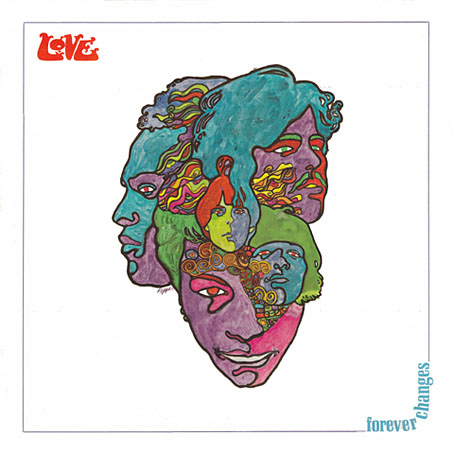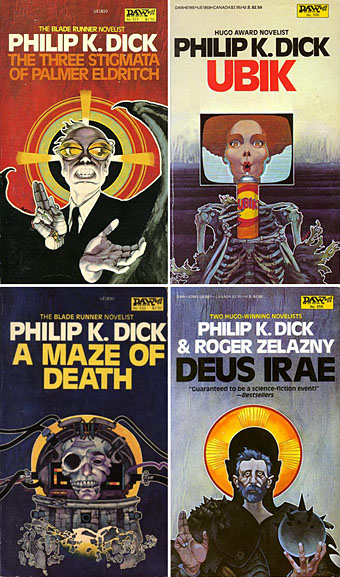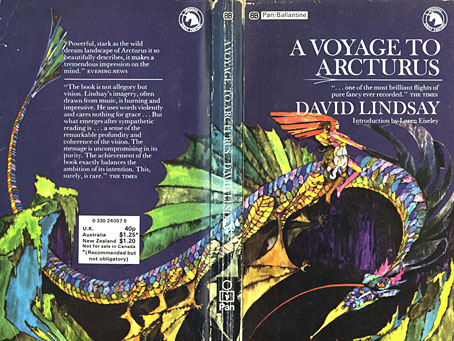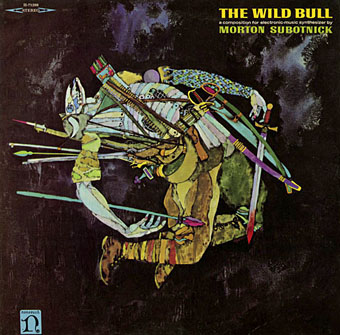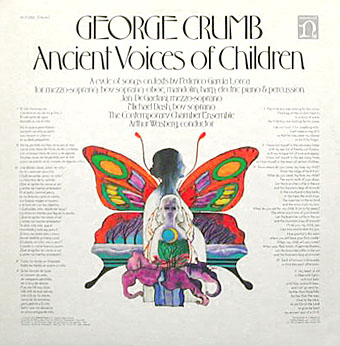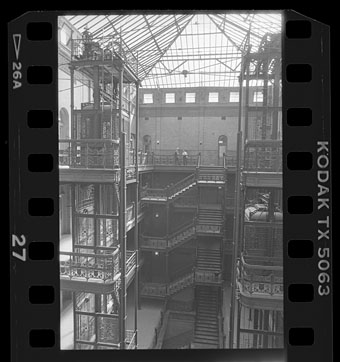The definitive Blade Runner
| The final director’s cut.
Tag: Blade Runner
The art of Bob Pepper
Forever Changes (1967) by Love.
Art by Bob Pepper, design by William S. Harvey.
Following yesterday’s post about Philip K Dick covers (and Erik Davis’s appraisal of the DAW cover), I decided to check out Bob Pepper’s work a bit more and it quickly became obvious I should have joined the dots with this particular artist years ago. Pepper’s work not only decorates one of the recognisable record sleeves of the late Sixties (above), he was working shortly afterwards as an illustrator on the celebrated series of fantasy reprints edited by Lin Carter for Ballantine books. Pepper’s connections with Elektra Records also saw him provide sleeve art for some of the eclectic releases on their Nonesuch label. What’s surprising to me now is the realisation that I’d been seeing his work for years in a variety of places and never noticed it was the same artist. Better late than never, I suppose.
Four more Dick covers for a series of six published in 1982 to coincide with the release of Blade Runner. As with the cover for A Scanner Darkly (in the earlier post) these paintings are all portraits.
A Voyage to Arcturus (1968) by David Lindsay.
It was the success of the publication of The Lord of the Rings in America which inspired Betty Ballantine to publish a line of fantasy classics in the late Sixties. The series began its run in 1969 and continued until 1974. Lin Carter was commissioned as editor and given free reign to choose any title he thought might be suitable with the result that many of the books in the series—obscurities such as Lud-in-the-mist by Hope Mirrlees—received their first paperback publication. Carter also reprinted personal favourites which frequently shifted from fantasy to outright horror, such as the titles from HP Lovecraft and William Hope Hodgson. The range and scope of this line is what makes the series so notable today and the books have become highly-collectable as a result. Many artists were involved in producing the distinctive cover designs and Pepper’s illustrations were featured on the covers for Mervyn Peake, Lord Dunsany and James Branch Cabell, among others. Unfortunately the various pages devoted to these books aren’t very good at showing the paintings to their best advantage. For a long time Pepper’s cover for A Voyage to Arcturus was one of the few editions available that managed to show a scene from the book, rather than a generic sword-wielding barbarian.
The Wild Bull (1968) by Morton Subotnick.
Nonesuch Records was Elektra’s subsidiary classical music label which not only produced classical recordings but also recordings from around the world in their Explorer series, and a range of original works of contemporary electronic music. I’m not positive that the sleeve above is a Pepper painting but it certainly looks like it. This is another surprise since I’ve had Morton Subnotnick‘s album on a reissue CD for years (with different artwork). The George Crumb recording below is Pepper’s work and I’ve had the original vinyl of that one for several years. The similarity between that sleeve and the one for Love is striking.

Flesh (1969) by Philip José Farmer.
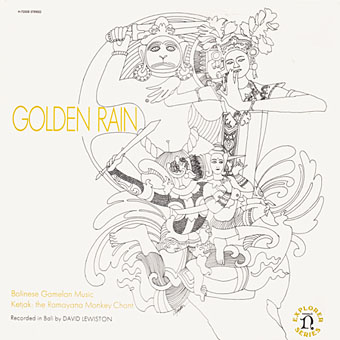
Golden Rain – Balinese Gamelan Music – Ketjak: The Ramayana Monkey Dance (1969) by Various Artists.
Art by Bob Pepper, design by William S. Harvey.
Ancient Voices of Children (1971) by George Crumb.
Art by Bob Pepper, design by Robert W. Zingmark.
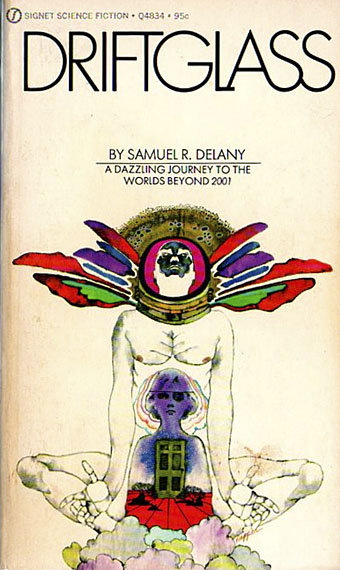
Driftglass (1971) by Samuel R. Delany.

Debussy’s Greatest Hits (1972).
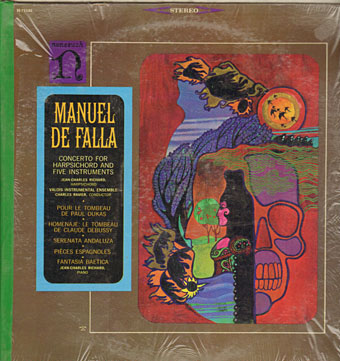
Concerto For Harpsichord And Five Instruments by Manuel De Falla (no date).

Ellison Wonderland (1974) by Harlan Ellison.
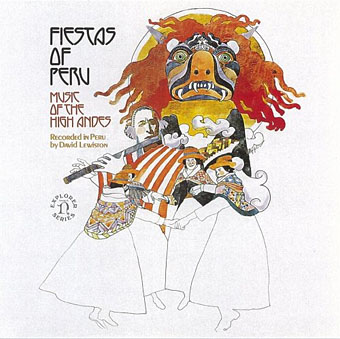
Fiestas of Peru: Music of the High Andes (1975) by Various Artists.
Art by Bob Pepper, design by Jo Ann Gruber.

Flower Dance: Japanese Folk Melodies (no date) by Kofu Kikusui, The Noday Family, Nakagawa & Oishi.
Art by Bob Pepper, direction by William S. Harvey, design by Elaine Gongora.
Pepper is retired now but produced artwork for Dark Tower, a fantasy boardgame, in 1981. The game still has its enthusiasts, and this site features a short interview with the artist.
Update: more about the Ballantine covers.
Update 2: a large scan of the George Crumb cover art.
Update 3: More album and book covers added.
Elsewhere on { feuilleton }
• The album covers archive
• The book covers archive
• The illustrators archive
Previously on { feuilleton}
• Philip K Dick book covers
• Masonic fonts and the designer’s dark materials
The Bradbury Building: Looking Backward from the Future
The Bradbury Building, 304 South Broadway, Los Angeles.
This looks like an old photograph but it actually dates from 1989 and comprises part of the Changing Times: Los Angeles in Photographs, 1920-1990 archive that the UCLA Library has recently made public.
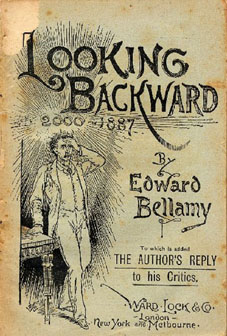 The Bradbury Building (constructed in 1893) was one of the few places I insisted on searching out when I was visiting the city in 2005. That enthusiasm dates from first seeing the building’s interior in Blade Runner where Ridley Scott turned its carefully-preserved atrium into JF Sebastian’s run-down apartment building. All that wrought-iron and polished terracotta (and those elevators!) would be compelling enough on their own but their history as a setting for a several film and TV productions only adds to their enchantment. That a building from the 1890s should be known primarily for its role in a science fiction film perhaps isn’t so surprising when it transpires that the Bradbury’s architect, George Wyman, had been inspired by a passage in a contemporary novel of futurist fantasy, Edward Bellamy’s Looking Backward: From 2000 to 1887:
The Bradbury Building (constructed in 1893) was one of the few places I insisted on searching out when I was visiting the city in 2005. That enthusiasm dates from first seeing the building’s interior in Blade Runner where Ridley Scott turned its carefully-preserved atrium into JF Sebastian’s run-down apartment building. All that wrought-iron and polished terracotta (and those elevators!) would be compelling enough on their own but their history as a setting for a several film and TV productions only adds to their enchantment. That a building from the 1890s should be known primarily for its role in a science fiction film perhaps isn’t so surprising when it transpires that the Bradbury’s architect, George Wyman, had been inspired by a passage in a contemporary novel of futurist fantasy, Edward Bellamy’s Looking Backward: From 2000 to 1887:
It was the first interior of a twentieth-century public building that I had ever beheld, and the spectacle naturally impressed me deeply. I was in a vast hall full of light, received not alone from the windows on all sides, but from the dome, the point of which was a hundred feet above. Beneath it, in the centre of the hall, a magnificent fountain played, cooling the atmosphere to a delicious freshness with its spray. The walls and ceiling were frescoed in mellow tints, calculated to soften without absorbing the light which flooded the interior.
Wyman’s exterior is fairly nondescript even beside the younger buildings which now surround it, a fairly ordinary office building of the period. It’s the Bellamy-inspired atrium which captures the imagination and one can only wonder what the result might have been had Bellamy been a bit more liberal with his descriptions of America in the year 2000.
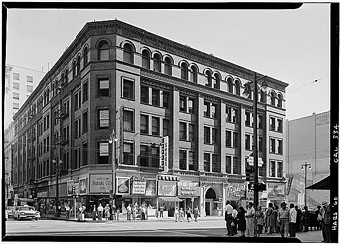
The building exterior and South Broadway entrance.
Blade Runner wasn’t the first film to make use of the Bradbury’s interior, Billy Wilder’s film noir Double Indemnity used the building’s offices as a location in 1944 and six years later Edmond O’Brien found his way there in the climax to another noir thriller D.O.A., directed by Rudolph Maté. This is the film that famously begins with O’Brien’s character staggering into a police station to report a murder—his own. He’s been dosed with a slow-acting poison, something possibly radioactive, as was the fashion of the time. He has a few hours in which to find his killer and his breathless chase leads him to an empty Bradbury building at night, all spider-webbed with shadows.

D.O.A. (1950).
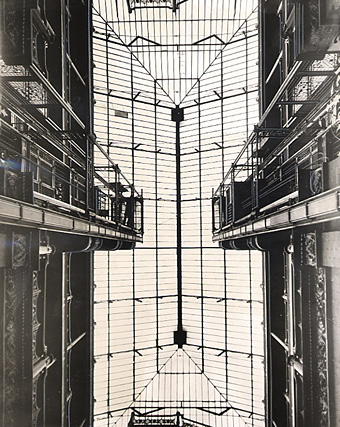
The atrium roof, circa 1961.
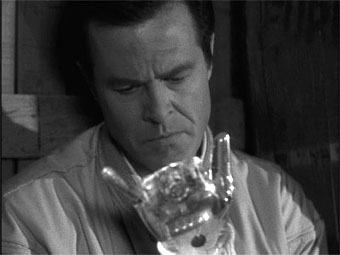
Robert Culp: ‘Demon With A Glass Hand’ (1964).
“I was born ten days ago. A full grown man…born ten days ago. I woke on the streets of this city. I don’t know who I am, where I’ve been, or where I’m going. Someone wiped my memories clean. And they tracked me down and they tried to kill me. Why? Who are you? I ran. I managed to escape them the first time. The hand…my hand…told me what to do….”
The splendid atrium was put to even better use in 1964 for what’s often regarded as the best episode of The Outer Limits, the award-winning ‘Demon With a Glass Hand‘ written by Harlan Ellison. In that TV play the mysterious, amnesiac Trent (a great performance by Robert Culp) finds himself trapped inside the Bradbury after the building is besieged by the Kyben, alien invaders who chased him from the future and who who want both him and the computer he has fitted into his artificial hand. The building proves to be the location of a “time mirror” which enables Trent to return to the future after he’s defeated the Kyben and saved the future human race.
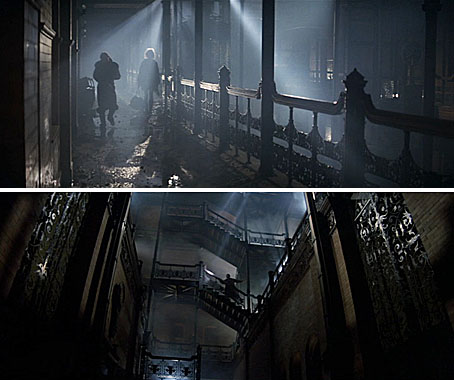
Blade Runner (1982).
We had been searching for locations for a building. We wanted to go on location to an old, decrepit building and take a suite of rooms and use that as Sebastian’s apartment. One day we were downtown Los Angeles looking at a possible location, and I took a stroll across the street with Ridley and a few other people and Ridley took a look inside the beautiful Bradbury building. What we did to that building you wouldn’t believe. On a superficial level we trashed it with high-tech, then filled it with smoke on the inside and shot at night. We also added a canopy with big columns to make it look like it was an old apartment building. All of a sudden we had a very gothic, eerie environment.
Lawrence G. Paull, Blade Runner production designer in Future Noir: The Making of Blade Runner by Paul M. Sammon.
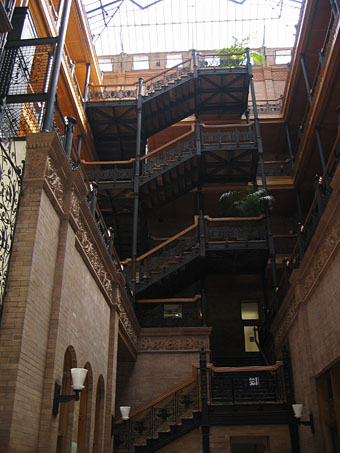
One of my photographs from 2005.
It’s tempting to see Blade Runner‘s vision of Los Angeles as a movie mash-up of the Bradbury’s noir thriller heritage with Bellamy and Ellison’s science fiction scenarios. In Britain such an elegant interior would only ever be used for Victorian costume dramas. The Bradbury’s movie life has mostly been a result of expediency and its convenience as a cheap, ready-made set, but this hasn’t prevented talented filmmakers from showing what can be done with a decent storyline and some photogenic architecture.
D.O.A. is now available as a free download after its copyright lapsed. And you can read Edward Bellamy’s Looking Backward (if you must) here. ‘Demon With A Glass Hand’ is available on DVD along with the rest of the Outer Limits episodes. Blade Runner was finally released in a better DVD edition last year but we’re still awaiting the multi-disc edition of Ridley’s masterpiece.
Previously on { feuilleton }
• Raw Deal
• Film noir posters
• Kiss Me Deadly
• The future is now
• Blade Runner DVD
• Downtown LA by Ansel Adams
Jodorowsky on DVD
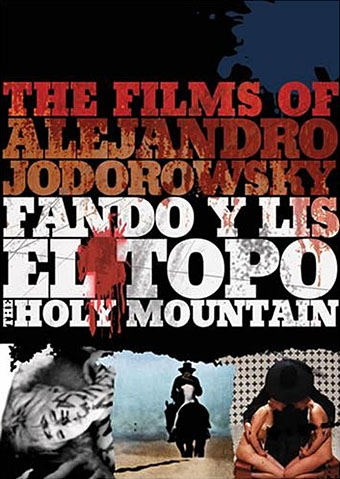
I am an artist. Now the pictures are not made by artists. They are made by companies and produced by multinationals. The art in the picture is lost. Now when artists make pictures, they make them for museums. But museums, for me, are cemeteries.
Alejandro Jodorowsky.
More from the About-Bleeding-Time Dept. (emphasis on “bleeding” in this case). Some of the most extraordinary films ever made finally receive an authorised DVD release in May.
Anchor Bay will release a special limited edition collector’s box set, The Films of Alejandro Jodorowsky, on DVD on 5/1/2007 (SRP $49.98). The set will contain El Topo, The Holy Mountain and Fando Y Lis on DVD, fully restored and remastered from new HD transfers in anamorphic widescreen video, with Dolby Digital 5.1 and 2.0 audio (El Topo is 125 minutes in Spanish, The Holy Mountain is 114 minutes in English, Fando Y Lis is 93 minutes in Spanish). The box set will also include 2 music CDs containing the soundtracks for El Topo and The Holy Mountain, as well as a DVD of Jodorowsky’s never-before-released first film, La Cravate. El Topo and The Holy Mountain will also be available separately (SRP $24.98 each). The El Topo DVD will contain audio commentary by the director, the original theatrical trailer (with English voice-over), a 2006 on-camera interview with the director as well as an exclusive new interview, a photo gallery and original script excerpts. The Holy Mountain DVD will include audio commentary with the director, deleted scenes with commentary, the original theatrical trailer (with English voice-over), the Tarot short with commentary, a restoration process short, restoration credits, a photo gallery and original script excerpts. Fando Y Lis will include audio commentary with the director and the La Constellation Jodorowsky documentary. Subtitles on the discs will be available in English, French, Spanish and Brazilian Portuguese.
• Jodorowsky’s official site (in Spanish)
• Jodorowsky discusses the new releases with Premiere Magazine
• Jay interviews Jodo: Mean Magazine | LA Weekly
Previously on { feuilleton }
• Jordan Belson on DVD
• Further back and faster
• Kenneth Anger on DVD…finally
• The Brothers Quay on DVD
• El Topo
• Gangsters on DVD
• Blade Runner DVD
• The Invasion of Thunderbolt Pagoda
Salvador Dalí’s apocalyptic happening
The oft-despised concept album of the 1970s doesn’t come more demented than 666, a double disc set by Greek group Aphrodite’s Child released in 1972. The group featured Vangelis and Demis Roussos among their number (Roussos later turned up on Vangelis’s score for Blade Runner) and this is about the only thing they’re now remembered for, a post-psychedelic fantasy based on the Book of Revelations. So far, so heavy. Searching for information about the album turned up a proposal by Salvador Dalí for a celebratory “happening” to be staged in Barcelona for the album’s world premiere (lyricist Costas Ferris having met Dalí in Paris shortly after the recording):
The main concept:
1. Martial Law shall be ordered on a Sunday, in Barcelona. No one shall be allowed to walk in the streets, or watch the event. No cameras, no TV. Only a young couple of shepherds will have the privilege to witness the event. So, they can later describe it to the people, by oral speech.
2. Giant loudspeakers shall be put in the streets, playing all day the work 666, by Vangelis, Ferris and the Aphrodite’s Child. No live performance.
3. Soldiers dressed in Nazi uniforms, will walk in military march in the streets of Barcelona, arresting who-ever wants to break the law.
4. Hundreds of swans will be left to move in front of the Sagrada Famiglia, with pieces of dynamite in their bellies, which will explode in slow motion by special effects. (real living swans, that should be operated for putting the dynamite inside their belly).
5. Giant Navy planes, will fly all day in the sky of Barcelona, provoking big noise.
6. At 12:00 sharp, in the mid-day, those planes will start the bombardment of the great church, throwing all of their munitions.
7. Instead of bombs, they shall throw Elephants, Hippopotami, Whales and Archbishops carrying umbrellas.
No, it didn’t happen, but if you do hear the album try and think of swans exploding in slow motion while elephants and archbishops rain down from the sky.
Previously on { feuilleton }
• The apocalyptic art of Francis Danby
• The music of Igor Wakhévitch
• Dalí Atomicus

